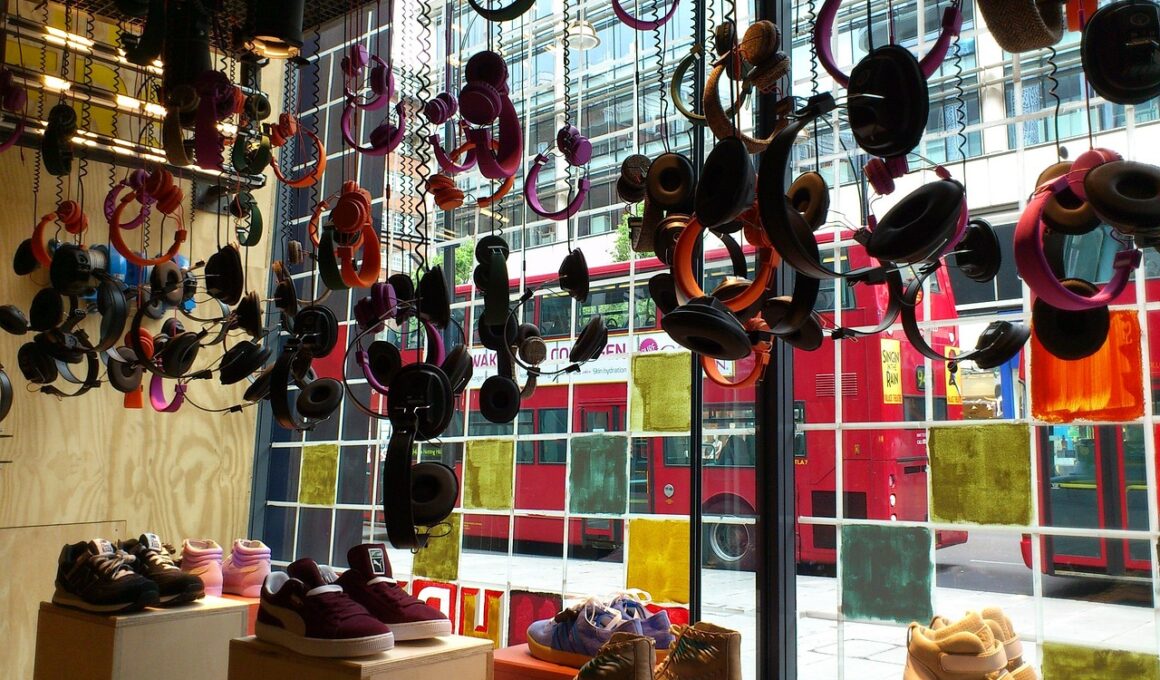The Impact of Visual Merchandising on Retail Sales
Visual merchandising is a critical component in retail marketing that can greatly influence sales. Effective visual strategies not only attract customers but also enhance their shopping experience, leading to increased purchasing decisions. By optimizing product placement, store layout, and signage, retailers can guide consumer behavior. When shoppers encounter well-displayed products, their interest is piqued, which can lead to impulse purchases. The strategic use of lighting and colors also plays a significant role; warm lights may create a relaxed atmosphere, encouraging longer shopping times. Store displays that tell a story or convey a seasonal theme can evoke emotions, enhancing the connection between the customer and the product. Innovative techniques, like digital displays, can engage customers more interactively. Thus, mastering visual merchandising becomes essential for retailers aiming to elevate their sales figures. The ability to create a compelling shopping environment sets successful retailers apart from their competitors, driving traffic and fostering customer loyalty. Ultimately, investing in visual merchandising strategies promotes a comprehensive retail experience, transforming standard transactions into memorable interactions that positively impact overall sales performance.
Effective window displays are vital for attracting foot traffic into a store. They serve as the first impression for potential customers walking by. A well-crafted window display can significantly increase curiosity and invite people inside. Retailers must regularly refresh their displays to keep passersby engaged. Seasonal themes, new products, or promotional sales should be showcased prominently. It is essential that the display aligns with the brand’s identity while still appealing to the target audience. Techniques such as layering products attract attention and encourage exploration. Including experiential elements, like interactive components or sensory displays, can enhance the shopping experience. Additionally, clear signage indicating promotions or highlighting unique offerings informs customers and builds excitement. By leveraging these strategies, retailers can effectively entice customers, thereby increasing foot traffic and, subsequently, sales. Effective execution of window displays becomes both an art and a science. These displays should speak to the brand narrative and align with wider marketing strategies, maximizing their potential impact. Retailers who understand the nuances of visual merchandising reap the benefits in sales growth and customer engagement.
The Role of Signage in a Retail Environment
Signage plays a multifaceted role in enhancing visual merchandising within retail environments. Clear and engaging signs provide essential information to customers, simplifying navigation within the store. When shoppers can easily identify product categories or promotions, they spend less time searching and more time purchasing. This efficiency is crucial in driving sales. Signage can also reinforce branding, as visually cohesive signs contribute to creating a strong brand identity. Use of engaging fonts and colors not only draw attention but communicate brand values. Effective signage highlights key products, directing focus where it is most beneficial. Digital signs may also enhance this by allowing for dynamic displays that can be frequently updated. Seasonal sales or flash promotions can be displayed instantaneously, creating urgency among consumers. In addition, directional signage aids in streamlining traffic flow, minimizing congestion and enhancing the shopping experience. A thoughtful signage strategy makes a retail space more welcoming, ensuring that customers feel guided rather than lost. Thus, the careful integration of signage into visual merchandising strategies can positively impact customer experiences and retail success.
The strategic organization of merchandise within a physical space can significantly influence consumer purchasing behavior. Retail layout design plays an essential role in visual merchandising, as it determines customers’ journey through the store. Thoughtful arrangements create pathways that encourage exploration while ensuring that high-margin products receive prominence. For example, placing popular items at the back draws customers deeper into the store, exposing them to more product interactions. Employing sensory experiences, such as enticing scents or soundscapes, can augment the shopping journey, creating positive associations with the brand. Furthermore, grouping complementary products together creates opportunities for cross-selling, enhancing the average transaction value. Techniques such as product layering or the use of mannequins can showcase items in a way that allows the shoppers to envision their use in daily life. Seasonal displays can also highlight new arrivals or promotional products, further enticing customers. Ultimately, visual merchandising strategies focused on effective layout design foster a more engaging environment, leading to higher sales and improved customer satisfaction. Retailers that truly understand these principles are well-positioned to capitalize on their physical spaces.
Emotional Influence of Colors and Lighting
The emotional impact of color psychology and lighting cannot be overstated in the realm of retail marketing. Colors evoke specific feelings and associations. For instance, red is often associated with urgency and excitement, making it effective for clearance sales. Blue, on the other hand, instills a sense of trust and calm, appealing to consumers in a more luxurious retail setting. Lighting further enhances this emotional connection; bright, white lighting may energize customers, while softer tones can create a comforting atmosphere. Retailers must balance these elements to align with brand identity and target demographics. The use of accent lighting can direct focus toward specific products or displays, driving sales further. Additionally, seasonal changes in lighting design can create a fresh shopping environment, influencing consumer behavior positively. Experimenting with lighting techniques, such as dimming or highlighting, can evoke specific moods aligned with product lines. By mastering the interplay between color and lighting, retailers can transform their spaces into inviting environments that encourage shopping. These strategies are essential in ensuring a seamless connection between merchandise and customer experience.
Incorporating digital elements into visual merchandising strategies is becoming increasingly important in the retail landscape. Digital signage, augmented reality, and interactive displays provide innovative ways to engage customers. Retailers can utilize large screens to showcase videos of product applications, which can captivate shoppers. Additionally, augmented reality apps may allow customers to visualize how products integrate into their lives. Creating immersive experiences creates a memorable shopping journey that retains customer interest. Retailers must consider which digital elements resonate most with their target audience, tailoring their approach accordingly. The integration of technology enhances traditional visual merchandising techniques by providing real-time information, promotions, and even personalized offers. However, it is crucial to strike a balance; heavy reliance on digital elements should not detract from the tactile experience customers expect. Striving for harmony between technology and traditional retail practices can amplify effectiveness. By combining intuitive interfaces with engaging content, retailers can position themselves favorably in a competitive market. Remaining attuned to technological advancements ensures that visual merchandising strategies evolve alongside changing customer preferences.
Measuring the Success of Visual Merchandising Efforts
Finally, measuring the success of visual merchandising strategies is essential for understanding their impact on retail sales. Various metrics can provide insight into performance levels, such as foot traffic, conversion rates, and average transaction value. Retailers must analyze these metrics over time to discern patterns and adjust strategies accordingly. Tools like heat maps can illustrate customer movements within the store, revealing which displays attract the most attention. Gathering feedback directly from consumers can offer qualitative data about their experience and preferences. This information can help retailers identify successful approaches and areas in need of improvement. A/B testing different visual merchandising techniques allows for assessing real-time effectiveness, ensuring that resources are allocated optimally. Retailers must remain agile in their strategies, responding swiftly to consumer trends and behavioral insights. As the retail landscape continues adapting to evolving expectations, the ability to measure and refine visual merchandising efforts becomes paramount. The focus should remain on creating positive experiences that resonate with customers, driving loyalty. Implementing a continuous feedback loop can facilitate long-term success.
Through the careful analysis and implementation of various visual merchandising strategies, retailers can significantly boost sales. Emphasizing techniques such as engaging window displays, strategic signage, and effective layout design creates an inviting shopping atmosphere. The impact of colors and lighting influences emotional connections, while the adoption of digital elements adds a modern edge. Consistent evaluation enables retailers to adapt their strategies based on customer behaviors. As consumer expectations shift, remaining receptive to these changes is vital for sustaining success. Ultimately, the integration of compelling visual merchandising principles fosters customer interactions that go beyond transactions, enhancing brand loyalty and long-term profitability.


